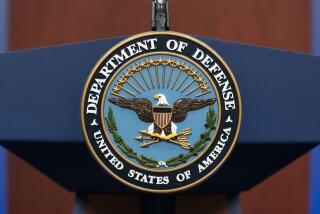U.S., Troops Pay Price in Cycle of Deployments
- Share via
WASHINGTON — The Clinton administration avoided pounding Iraq this weekend, but it did not find a way out of a frustrating cycle of Persian Gulf troop buildups and reductions that is both expensive and disruptive to the armed forces.
The Pentagon spent $1.4 billion on the buildup that began about a year ago, and it will wind up spending another hefty amount on this month’s buildup as well. These surges cut into the training of military personnel, strain their family lives and complicate a busy worldwide deployment schedule that has recently been blamed for driving many troops out of the services altogether.
Critics, chafing at the sight of Iraqi President Saddam Hussein toying with the world’s most powerful military, contend that the situation adds up to one of the most embarrassing aspects of the administration’s beleaguered Iraq policy.
“We simply cannot leave a large force over there for an indeterminate amount of time,” Sen. John McCain (R-Ariz.) said Sunday on ABC-TV. “These men and women are badly overcommitted, overtaxed, overworked. They’re getting out in droves.”
The size of the U.S. force in the region has fluctuated since the end of the Persian Gulf War in 1991. The force was bolstered in 1993 in response to threatening moves by Hussein and swelled again last November as Hussein challenged United Nations weapons inspectors.
The buildup that began early this month was intended to bring more than 300 warplanes and about 30 ships to the region and to boost the presence of 23,500 troops by at least 3,000.
Andrew F. Krepinevich, executive director of the Center for Strategic and Budgetary Assessments in Washington, said it costs about $150 million a month to support what the Pentagon has come to view as a full-sized emergency force in the region.
Krepinevich, who noted that the Pentagon budgeted $747 million this year for operations in the region, predicted that special deployments will drive the figure to between $1 billion and $2 billion in fiscal 1999, which started Oct. 1. (That compares with about $1.8 billion spent annually to maintain a force of 8,000 U.S. troops in Bosnia-Herzegovina.)
And the dollars aren’t all. “It pushes the military just a bit more toward the ragged edge of readiness,” Krepinevich said.
Military personnel in many specialties need to practice their skills routinely to keep them in top shape, and they may lose that edge on deployments, where their training opportunities tend to be limited.
Air Force pilots who patrol the “no-fly” zones in northern and southern Iraq log long hours in the pilot’s seat. But their flying is routine, without the kind of maneuvering or target practice that they would find in exercise ranges over Nevada, for example.
“They’re boring holes in the sky,” Krepinevich said. “It’s the difference between being a fighter pilot and an airline pilot.”
Army tanks crews, to take another example, can sometimes practice on simulators while on overseas deployments. But they can’t train, as in the United States, for complex exercises where the movements of armored columns are coordinated with those of artillery and infantry.
“Those are the skills that erode, and those are the skills that really give the U.S. military an edge over everybody else,” Krepinevich said.
Deployment also takes a toll on family lives at a time when more military personnel are married. And that, in turn, is a reason why military personnel in key specialties have been leaving the services for civilian posts in the past several years.
“It’s a costly proposition in a lot of ways--in money and in the toll it takes on our people,” one officer said.
Many analysts hold out little hope that the United States will be able to extricate itself from this cycle.
If Hussein begins creating trouble again within weeks or months, as many expect, the U.S. forces will be required to resume their buildup.
And if the United States decides to abandon its reliance on United Nations weapons inspections, content simply to try to contain Hussein from outside Iraq’s borders, U.S. forces may still be required to stay in the region.
Sensitive to this criticism, defense officials have taken steps to try to ease the cost and disruption of the deployments.
They are working to cut the time required for each deployment cycle. This month’s buildup, for example, was to be complete in about three weeks, compared with the nearly three months required last year.
On Sunday evening, officials said the Pentagon had begun sending back to their regular bases the warplanes that had been dispatched to the Gulf during the previous four days; it had already decided to delay deployment of 3,000 troops.
The Air Force is in the midst of a sweeping reorganization aimed at dividing the burden of deployments more equally.
Yet defense officials acknowledge that the issue cannot be easily resolved.
“We’re keenly aware of this, and we’ve done a lot to minimize it,” one official said. “We haven’t solved it.”
More to Read
Get the L.A. Times Politics newsletter
Deeply reported insights into legislation, politics and policy from Sacramento, Washington and beyond. In your inbox twice per week.
You may occasionally receive promotional content from the Los Angeles Times.











